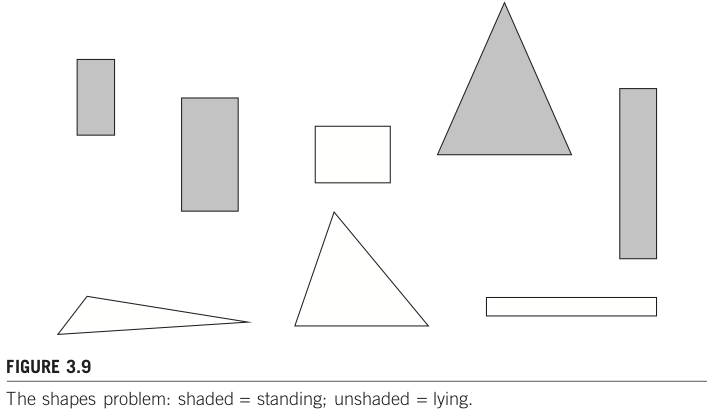グラフマイニングの例
目次
30. グラフマイニングの例¶
データセット
social circles: Facebookから facebook_combined.txt.zip を利用。
graph1.txt, graph2.txt, graph_modularity_simple.txt: 小さなグラフ例
ツール等
Graphviz: ノードとエッジで構成されるグラフ描画ツール。
pygraphviz: GraphvizをPythonから使うためのラッパー。
networkx: ネットワーク解析パッケージ。
30.1. 環境構築¶
!apt install libgraphviz-dev
!pip install pygraphviz
Reading package lists... Done
Building dependency tree
Reading state information... Done
The following additional packages will be installed:
libgail-common libgail18 libgtk2.0-0 libgtk2.0-bin libgtk2.0-common
libgvc6-plugins-gtk libxdot4
Suggested packages:
gvfs
The following NEW packages will be installed:
libgail-common libgail18 libgraphviz-dev libgtk2.0-0 libgtk2.0-bin
libgtk2.0-common libgvc6-plugins-gtk libxdot4
0 upgraded, 8 newly installed, 0 to remove and 39 not upgraded.
Need to get 2,120 kB of archives.
After this operation, 7,128 kB of additional disk space will be used.
Get:1 http://archive.ubuntu.com/ubuntu bionic/main amd64 libgtk2.0-common all 2.24.32-1ubuntu1 [125 kB]
Get:2 http://archive.ubuntu.com/ubuntu bionic/main amd64 libgtk2.0-0 amd64 2.24.32-1ubuntu1 [1,769 kB]
Get:3 http://archive.ubuntu.com/ubuntu bionic/main amd64 libgail18 amd64 2.24.32-1ubuntu1 [14.2 kB]
Get:4 http://archive.ubuntu.com/ubuntu bionic/main amd64 libgail-common amd64 2.24.32-1ubuntu1 [112 kB]
Get:5 http://archive.ubuntu.com/ubuntu bionic/universe amd64 libxdot4 amd64 2.40.1-2 [15.7 kB]
Get:6 http://archive.ubuntu.com/ubuntu bionic/universe amd64 libgvc6-plugins-gtk amd64 2.40.1-2 [18.2 kB]
Get:7 http://archive.ubuntu.com/ubuntu bionic/universe amd64 libgraphviz-dev amd64 2.40.1-2 [57.3 kB]
Get:8 http://archive.ubuntu.com/ubuntu bionic/main amd64 libgtk2.0-bin amd64 2.24.32-1ubuntu1 [7,536 B]
Fetched 2,120 kB in 1s (1,456 kB/s)
Selecting previously unselected package libgtk2.0-common.
(Reading database ... 160772 files and directories currently installed.)
Preparing to unpack .../0-libgtk2.0-common_2.24.32-1ubuntu1_all.deb ...
Unpacking libgtk2.0-common (2.24.32-1ubuntu1) ...
Selecting previously unselected package libgtk2.0-0:amd64.
Preparing to unpack .../1-libgtk2.0-0_2.24.32-1ubuntu1_amd64.deb ...
Unpacking libgtk2.0-0:amd64 (2.24.32-1ubuntu1) ...
Selecting previously unselected package libgail18:amd64.
Preparing to unpack .../2-libgail18_2.24.32-1ubuntu1_amd64.deb ...
Unpacking libgail18:amd64 (2.24.32-1ubuntu1) ...
Selecting previously unselected package libgail-common:amd64.
Preparing to unpack .../3-libgail-common_2.24.32-1ubuntu1_amd64.deb ...
Unpacking libgail-common:amd64 (2.24.32-1ubuntu1) ...
Selecting previously unselected package libxdot4.
Preparing to unpack .../4-libxdot4_2.40.1-2_amd64.deb ...
Unpacking libxdot4 (2.40.1-2) ...
Selecting previously unselected package libgvc6-plugins-gtk.
Preparing to unpack .../5-libgvc6-plugins-gtk_2.40.1-2_amd64.deb ...
Unpacking libgvc6-plugins-gtk (2.40.1-2) ...
Selecting previously unselected package libgraphviz-dev.
Preparing to unpack .../6-libgraphviz-dev_2.40.1-2_amd64.deb ...
Unpacking libgraphviz-dev (2.40.1-2) ...
Selecting previously unselected package libgtk2.0-bin.
Preparing to unpack .../7-libgtk2.0-bin_2.24.32-1ubuntu1_amd64.deb ...
Unpacking libgtk2.0-bin (2.24.32-1ubuntu1) ...
Setting up libgtk2.0-common (2.24.32-1ubuntu1) ...
Setting up libxdot4 (2.40.1-2) ...
Setting up libgtk2.0-0:amd64 (2.24.32-1ubuntu1) ...
Setting up libgail18:amd64 (2.24.32-1ubuntu1) ...
Setting up libgail-common:amd64 (2.24.32-1ubuntu1) ...
Setting up libgvc6-plugins-gtk (2.40.1-2) ...
Setting up libgraphviz-dev (2.40.1-2) ...
Setting up libgtk2.0-bin (2.24.32-1ubuntu1) ...
Processing triggers for man-db (2.8.3-2ubuntu0.1) ...
Processing triggers for libc-bin (2.27-3ubuntu1.2) ...
/sbin/ldconfig.real: /usr/local/lib/python3.7/dist-packages/ideep4py/lib/libmkldnn.so.0 is not a symbolic link
Collecting pygraphviz
?25l Downloading https://files.pythonhosted.org/packages/3a/d6/2c56f09ee83dbebb62c40487e4c972135661b9984fec9b30b77fb497090c/pygraphviz-1.7.zip (118kB)
|████████████████████████████████| 122kB 7.9MB/s
?25hBuilding wheels for collected packages: pygraphviz
Building wheel for pygraphviz (setup.py) ... ?25l?25hdone
Created wheel for pygraphviz: filename=pygraphviz-1.7-cp37-cp37m-linux_x86_64.whl size=166142 sha256=6bbbb96a20c7c22804e6b3f842eb5a71b5a652364c064af09c58727fae084d8b
Stored in directory: /root/.cache/pip/wheels/32/59/00/14934a4292c4359eeabcdbf90f33d309b55d0f1be8a1262523
Successfully built pygraphviz
Installing collected packages: pygraphviz
Successfully installed pygraphviz-1.7
import pandas as pd
import networkx as nx
import pygraphviz
import matplotlib.pyplot as plt
30.2. やや大きめの実データを用いたグラフ化例¶
facebook_combined.txt には「どのノード間にエッジがあるか」というリンク情報が保存されている。例えば「0 1」という行なら「ノード0とノード1の間にエッジがある」ことを意味している。
このままではグラフではないため、データを一度DataFrameとして読み込み、それを from_edges_to_networks() によりグラフに変換する。
30.2.1. データ準備(facebook_combined.txt)¶
!curl -O http://snap.stanford.edu/data/facebook_combined.txt.gz
!gzip -d facebook_combined.txt.gz
% Total % Received % Xferd Average Speed Time Time Time Current
Dload Upload Total Spent Left Speed
100 213k 100 213k 0 0 808k 0 --:--:-- --:--:-- --:--:-- 808k
!head facebook_combined.txt
0 1
0 2
0 3
0 4
0 5
0 6
0 7
0 8
0 9
0 10
filename = "facebook_combined.txt"
df = pd.read_csv(filename, sep=' ')
df[:5]
| 0 | 1 | |
|---|---|---|
| 0 | 0 | 2 |
| 1 | 0 | 3 |
| 2 | 0 | 4 |
| 3 | 0 | 5 |
| 4 | 0 | 6 |
# エッジ数の確認(上位10件)
counts = df['0'].value_counts()
counts[:10]
107 1043
1684 778
1912 748
3437 542
0 346
348 225
1941 215
1985 207
483 191
1917 189
Name: 0, dtype: int64
30.2.2. エッジ集合のDataFrameからグラフに変換¶
# グラフ変換
def from_edges_to_networks(filename):
"""グラフ読み込み
Graphvizのラッパーであるpygraphvizにデータを渡すため、
netoworkx.Graph()へノードとエッジ集合を読み込む。
"""
G = nx.Graph()
with open(filename) as fh:
for line in fh:
edges = list(map(int, line.split(" ")))
G.add_edge(edges[0], edges[1])
return G
G = nx.read_edgelist(filename, nodetype=int)
# ノード数、エッジ数の確認
print(nx.number_of_nodes(G), nx.number_of_edges(G))
4039 88234
30.2.3. グラフ描画¶
直接描画することが困難なサイズなので、一度ファイルに保存し、それを縮小したものを描画している。
# そのまま描画すると潰れてしまう、、
nx.draw(G)

# save graph
pos = nx.nx_agraph.pygraphviz_layout(G, prog='sfdp', args='-Goverlap=false -Tpng -o facebook.png')
from PIL import Image
from IPython.display import display
img = Image.open("facebook.png")
img_resize = img.resize((256,256)) # 画像リサイズ
img_resize.save("facebook_s.png")
with Image.open("facebook_s.png") as im:
display(im)

30.2.4. ネットワーク分析例¶
エッジ数をカウントし、エッジ数あたりの出現回数を描画。
上記をlog-scaleで描画。
# degree distribution
# normal scale
import collections
# ノード毎に有するエッジ数をカウント
count = []
for index_of_node in G.adj:
count.append(len(G.adj[index_of_node]))
count.sort()
temp = collections.Counter(count)
# エッジ数あたりの出現回数をカウント
degree, freq = zip(*temp.items())
plt.scatter(degree, freq, s=5)
plt.xlim(0, max(degree))
plt.ylim(0, max(freq))
plt.xlabel('degree')
plt.ylabel('freq')
plt.title(filename + ' (degree x freq)')
plt.show()
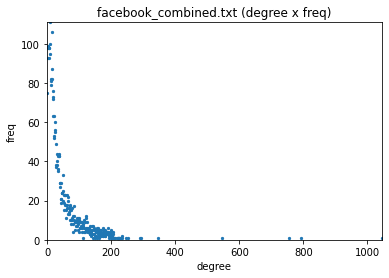
# log scale
plt.scatter(degree, freq, s=5)
plt.xscale('log')
plt.yscale('log')
plt.xlabel('degree (log10 scale)')
plt.ylabel('freq (log10 scale)')
plt.title(filename + ' (degree x freq) in log-scale')
plt.show()
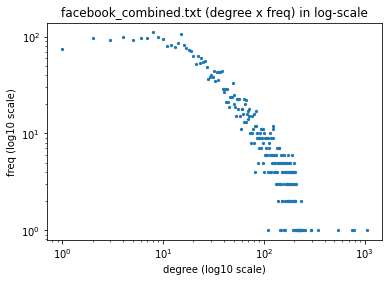
30.2.5. Zipfの法則っぽさを確認¶
zipf_values = []
for i in range(10,50):
value = i * freq[i]
zipf_values.append(value)
zipf_values
[810,
902,
948,
1131,
1484,
1230,
1216,
1241,
1296,
1197,
1040,
1323,
1166,
1380,
1320,
1400,
1274,
999,
1064,
1160,
1140,
1364,
1120,
1419,
1224,
1505,
1548,
1628,
1102,
1053,
1160,
861,
1218,
903,
836,
1080,
1104,
1128,
1584,
1225]
df = pd.DataFrame(zipf_values)
df.plot(kind='box')
<matplotlib.axes._subplots.AxesSubplot at 0x7f1ea0316f10>
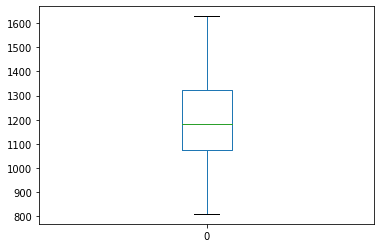
30.3. ページランクの例¶
30.3.1. データセットの用意¶
!curl -O https://raw.githubusercontent.com/naltoma/datamining_intro/master/4-casestudy/graph/graph1.txt
!curl -O https://raw.githubusercontent.com/naltoma/datamining_intro/master/4-casestudy/graph/graph2.txt
!ls
% Total % Received % Xferd Average Speed Time Time Time Current
Dload Upload Total Spent Left Speed
100 20 100 20 0 0 124 0 --:--:-- --:--:-- --:--:-- 124
% Total % Received % Xferd Average Speed Time Time Time Current
Dload Upload Total Spent Left Speed
100 122 100 122 0 0 734 0 --:--:-- --:--:-- --:--:-- 734
facebook_combined.txt facebook_s.png graph2.txt
facebook.png graph1.txt sample_data
!cat graph1.txt
A B
A C
B C
C A
D C
30.3.2. ランダムサーファーモデルによるシミュレーション¶
import random
def random_surfer(G, max_itr=1000, d=0.15):
"""ランダムサーファーモデルのシミュレーション。
ランダムなノードから出発し、そのページのout-edgesをランダムに選択して移動する。
ただし、確率dでページ遷移を辞め、無作為にノードを選んで再出発する。
:param G: networkx.classes.digraph.DiGraph。有向グラフ。
:param max_itr: ページ遷移回数。
:param d: エッジ選択から離脱する確率。
:return: 各ノードの訪問割合。
"""
num = len(nx.nodes(G))
nodes = list(nx.nodes(G))
reached = {}
count = 0
current = random.choice(nodes)
while True:
if current in reached:
reached[current] += 1
else:
reached.update({current:1})
count += 1
if count == max_itr:
break
if d < random.random():
targets = [target for cur, target in nx.edges(G, current)]
if len(targets) == 0:
break
current = random.choice(targets)
else:
current = random.choice(nodes)
continue
print(count,reached)
for node in reached.keys():
reached[node] /= count
return reached
filename = "graph1.txt"
G = nx.read_edgelist(filename, create_using=nx.DiGraph())
reached = random_surfer(G, 20)
print(reached)
2 {'A': 1, 'D': 1}
3 {'A': 1, 'D': 1, 'C': 1}
4 {'A': 2, 'D': 1, 'C': 1}
5 {'A': 2, 'D': 1, 'C': 1, 'B': 1}
6 {'A': 2, 'D': 1, 'C': 2, 'B': 1}
7 {'A': 3, 'D': 1, 'C': 2, 'B': 1}
8 {'A': 3, 'D': 1, 'C': 2, 'B': 2}
9 {'A': 3, 'D': 1, 'C': 3, 'B': 2}
10 {'A': 4, 'D': 1, 'C': 3, 'B': 2}
11 {'A': 4, 'D': 1, 'C': 4, 'B': 2}
12 {'A': 5, 'D': 1, 'C': 4, 'B': 2}
13 {'A': 5, 'D': 1, 'C': 5, 'B': 2}
15 {'A': 7, 'D': 1, 'C': 5, 'B': 2}
16 {'A': 7, 'D': 1, 'C': 6, 'B': 2}
17 {'A': 8, 'D': 1, 'C': 6, 'B': 2}
18 {'A': 8, 'D': 1, 'C': 7, 'B': 2}
19 {'A': 9, 'D': 1, 'C': 7, 'B': 2}
{'A': 0.45, 'D': 0.05, 'C': 0.35, 'B': 0.15}
30.3.3. networkx.pagerankによるランク評価¶
filename = "graph1.txt"
G = nx.read_edgelist(filename, create_using=nx.DiGraph())
# ランク算出
pr = nx.pagerank(G)
print(pr)
{'A': 0.372526246091333, 'B': 0.19582365458881654, 'C': 0.39415009931985023, 'D': 0.037500000000000006}
30.3.4. グラフ描画¶
# グラフ描画
pos = nx.spring_layout(G)
labels = {}
for node in pr.keys():
labels[node] = 'Node {}\n{}'.format(node, round(pr[node], 3))
G = nx.relabel_nodes(G, labels)
import graphviz
graphviz.Source(nx.nx_agraph.to_agraph(G))
30.4. 少し複雑なグラフでページランク確認¶
filename = "graph2.txt"
G = nx.read_edgelist(filename, create_using=nx.DiGraph())
# ランク算出
pr = nx.pagerank(G)
print(pr)
# グラフ描画
pos = nx.spring_layout(G)
labels = {}
for node in pr.keys():
labels[node] = 'Node {}\n{}'.format(node, round(pr[node], 3))
G = nx.relabel_nodes(G, labels)
#nx.nx_agraph.view_pygraphviz(G, prog='sfdp')
import graphviz
graphviz.Source(nx.nx_agraph.to_agraph(G))
#nx.draw_networkx(G)
{'1': 0.12174896105921995, '2': 0.04386978407256124, '3': 0.04386978407256124, '4': 0.04386978407256124, '5': 0.06530818443477784, '6': 0.10217580762337017, '7': 0.07144359556771177, '8': 0.05279920075611914, '15': 0.14450495559625123, '9': 0.03181526582418545, '10': 0.05885906219895707, '11': 0.02188284889175391, '12': 0.02188284889175391, '13': 0.02188284889175391, '14': 0.02188284889175391, '16': 0.13220421915470792}
30.5. モジュラリティの確認¶
30.6. データセットの用意¶
!curl -O https://raw.githubusercontent.com/naltoma/datamining_intro/master/4-casestudy/graph/graph_modularity_simple.txt
!head graph_modularity_simple.txt
% Total % Received % Xferd Average Speed Time Time Time Current
Dload Upload Total Spent Left Speed
0 0 0 0 0 0 0 0 --:--:-- --:--:-- --:--:-- 0
100 84 100 84 0 0 518 0 --:--:-- --:--:-- --:--:-- 521
1 2
1 3
1 4
1 5
2 3
2 4
2 5
3 4
3 5
4 5
30.6.1. girvan_newman方式のモジュラリティ評価¶
%matplotlib inline
from networkx.algorithms.community.centrality import girvan_newman
filename = "graph_modularity_simple.txt"
G = nx.read_edgelist(filename)
comp = girvan_newman(G)
print(tuple(sorted(c) for c in next(comp)))
#nx.nx_agraph.view_pygraphviz(G, prog='sfdp')
nx.draw_networkx(G)
(['1', '2', '3', '4', '5'], ['A', 'B', 'C', 'D', 'E'])
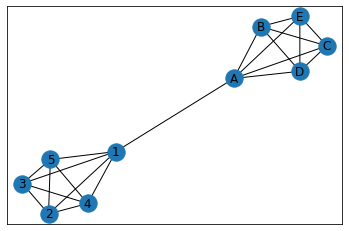
from networkx import community
clusters = []
clusters.append([{'1', '2', '3', '4', '5'}, {'A', 'B', 'C', 'D', 'E'}])
clusters.append([{'2', '3', '4', '5'}, {'1', 'A', 'B', 'C', 'D', 'E'}])
clusters.append([{'3', '4', '5'}, {'2', '1', 'A', 'B', 'C', 'D', 'E'}])
clusters.append([{'4', '5'}, {'2', '3', '1', 'A', 'B', 'C', 'D', 'E'}])
clusters.append([{'5'}, {'2', '3', '4', '1', 'A', 'B', 'C', 'D', 'E'}])
for i, cluster in enumerate(clusters):
modularity = community.modularity(G, cluster)
print('modularity(cluster{}) = {}'.format(i, modularity))
modularity(cluster0) = 0.45238095238095233
modularity(cluster1) = 0.2811791383219955
modularity(cluster2) = 0.12244897959183668
modularity(cluster3) = 0.02267573696145122
modularity(cluster4) = -0.018140589569161043
